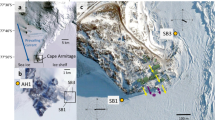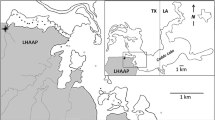Abstract
Although laboratory experimental studies have shown that copper is toxic to marine organisms at concentrations found in contaminated sediments, there is little unequivocal evidence of undesirable ecological effects in the field, other than at extreme concentrations. We describe a study in Botany Bay, New South Wales, Australia, in which the concentrations of copper in marine sediments were experimentally enhanced. Changes in the abundance and taxonomic composition of the fauna of copper-treated sediments relative to those of two control treatments were monitored over a period of six months. Univariate (ANOVA) and multivariate (non-metric multidimensional scaling, MDS) analyses of the changes in the fauna showed that increased concentrations of copper (140 to 1200 μg g-1 compared with background concentrations of 29 to 40 μg g-1) had an impact on the fauna. The nature of the response varied among taxa. For example, in some taxa, numbers of individuals decreased through time relative to controls, whereas the abundance of another taxon remained fairly constant through time in the copper treatment while numbers of control individuals increased. Differences in the changes of the faunas through time among the control and copper treatments were not always consistent among replicate experimental units 5 m apart, nor were they consistent between replicate experimental sites 100 m apart. The magnitudes of the changes in the faunas caused by the copper treatment are considered in the context of the magnitude of previously measured “natural” temporal variation.
Similar content being viewed by others
References
Adams WJ, Kimerle RA, Barnett Jr RA (1992) Sediment quality and aquatic life assessment. Envir Sci Technol 26: 1864–1875
Aller RC (1978) Experimental studies of changes produced by deposit feeders on pore water, sediment and overlying water chemistry. Am J Sci 278: 1185–1234
Andersen FO, Kristensen E (1991) Effects of burrowing macrofauna on organic matter decomposition in coastal marine sediments. Symp zool Soc Lond 63: 69–88
Ankley GT, Thomas NA, Di Toro DM, Hansen DJ, Mahony JD, Berry WJ, Swartz RC, Hoke RA (1994) Assessing potential bioavailability of metals in sediments: a proposed approach. Envir Mgmt 18: 331–337
Batley GE (1987) Heavy metal speciation in waters, sediments and biota from Lake Macquarie, New South Wales. Aust J mar Freshwat Res 38: 591–606
Bryan GW, Gibbs PE, Hummerstone LG, Burt GR (1987) Copper, zinc, and organotin as long-term factors governing the distribution of organisms in the Fal Estuary in southwest England. Estuaries 10: 208–219
Bryan GW, Langston WJ (1992) Bioavailability, accumulation and effects of heavy metals in sediments with special reference to United Kingdom estuaries: a review. Envir Pollut 76: 89–131
Chapman PM (1989) Current approaches to developing sediment quality criteria. Envir Toxic Chem 8: 589–599
Clarke KR (1993) Non-parametric multivariate analyses of changes in community structure. Aust J Ecol 18: 117–143
Connell JH (1974) Field experiments in marine ecology. In: Mariscal R (ed) Experimental marine biology. Academic Press, New York, pp 21–54
Ferraro SP, Cole FA (1990) Taxonomic level and sample size sufficient for assessing pollution impacts on the Southern Californian Bight macrobenthos. Mar Ecol Prog Ser 67: 251–262
Fisher RA (1958) Statistical methods for research workers. 13th edn. Oliver & Boyd, London
Förstner U, Wittman GTW (1979) Metal pollution in the aquatic environment. Springer-Verlag, Berlin
George SG (1990) Biochemical and cytological assessments of metal toxicity in marine animals. In: Furness RW, Rainbow PS (eds) Heavy metals in the marine environment. CRC Press, Boca Raton, Florida, pp 123–142
Grant A, Middleton R (1990) An assessment of metal contamination of sediments in the Humber Estuary (England, UK). Estuar, cstl Shelf Sci 31: 71–86
Gray JS, Clarke KR, Warwick RM, Hobbs G (1990) Detection of initial effects of pollution on marine benthos: an example from the Ekofisk and Eldfisk oifields, North Sea. Mar Ecol Prog Ser 66: 285–299
Green AS, Chandler GT (1994) Meiofaunal bioturbation effects on the partitioning of sediment-associated cadmium. J exp mar Biol Ecol 180: 59–70
Herman PM, Heip C (1988) On the use of meiofauna in ecological monitoring who needs taxonomy? Mar Pollut Bull 19: 665–668
Irvine I (1980) Sydney Harbour: sediments and heavy metal pollution. Unpublished PhD thesis. Department of Geology and Geophysics, University of Sydney
Langston WJ (1990) Toxic effects of metals and the incidence of metal pollution in marine ecosystems. In: Furness RW, Rainbow PS (eds) Heavy metals in the marine environment. CRC Press, Boca Raton, Florida, pp 101–122
Lewis AG, Cave WR (1982) The biological importance of copper in oceans and estuaries. Oceanogr mar Biol A Rev 20: 471–695
Long ER, MacDonald DD, Smith SL, Calder FD (1995) Incidence of adverse biological effects within ranges of chemical concentrations in marine and estuarine sediments. Envir Mgmt 19: 81–97
Long ER, Morgan LG (1991) The potential for biological effects of sediment-sorbed contaminants tested in the natural status and trends program. NOAA natn mar Fish Serv tech Memo US Dep Commerce NOS OMA 52: 1–175
Luoma SN (1990) Processes affecting metal concentrations in estuarine and coastal marine sediments. In: Furness RW, Rainbow PS (eds) Heavy metals in the marine environment. CRC Press, Boca Raton, Florida, pp 51–66
Macrae TH, Pandey AS (1991). Effects of toxic metals on early life stages of the brine shrimp, Artemia: a developmental toxicity assay. Archs envir Contam Toxic 20: 247–252
McLusky DS, Bryant V, Campbell R (1986) The effects of temperature and salinity on the toxicity of heavy metals to marine and estuarine invertebrates. Oceanogr mar Biol A Rev 24: 481–520
Meador JP (1991) The interaction of pH, dissolved organic carbon, and total copper in the determination of ionic copper and toxicity. Aquat Toxic 19: 13–32
Meador JP, Taub FB, Sibley TH (1993) Copper dynamics and the mechanism of ecosystem level recovery in a standardized aquatic microcosm. Ecol Applics 3: 139–155
Morrisey DJ, Howitt L, Underwood AJ, Stark JS (1992a) Spatial variation in soft-sediment benthos. Mar Ecol Prog Ser 81: 197–204
Morrisey DJ, Stark JS, Underwood AJ, Howitt L (1994) Spatial variation in concentrations of heavy metals in marine sediments. Aust J mar Freshwat Res 45: 177–184
Morrisey DJ, Underwood AJ, Howitt L (1996) Development of sediment-quality criteria — a proposal from experimental field-studies of the effects of copper on benthic organisms. Mar Pollut Bull (in press)
Morrisey DJ, Underwood AJ, Howitt L, Stark JS (1992b) Temporal variation in soft-sediment benthos. J exp mar Biol Ecol 164: 233–245
NRCC (1988) Biologically available metals in sediments. National Research Council of Canada, Associate Committee on Scientific Criteria for Environmental Quality, Ottawa, Canada (Publs natn Res Coun Can No. 27694)
Oakden JM, Oliver JS, Flegal AR (1984) Behavioral responses of a phoxocephalid amphipod to organic enrichment and trace metals in sediment. Mar Ecol Prog Ser 14: 253–257
Roper DS, Hickey CW (1994) behavioural responses of the marine bivalve Macomona liliana exposed to copper-and chlordanedosed sediments. Mar Biol 118: 673–680
Rygg B (1985) Effect of sediment copper on benthic fauna. Mar Ecol Prog Ser 25: 83–89
Salomons W, Förstner U (1984) Metals in the hydrocycle. Springer-Verlag, Berlin
Stiles S, Choromanski J, Nelson D, Miller J, Greig R, Sennefelder G (1991) Early reproductive success of the hard clam (Mercenaria mercenaria) from five sites in Long Island Sound (USA). Estuaries 14: 332–342
Swartz RC, Kemp PF, Schults DW, Lamberson JO (1988) Effects of mixtures of sediment contaminants on the marine amphipod, Rhepoxinius abronius. Envir Toxic Chem 7: 1013–1020
Szymczak R (1992) Diel transitions in the dissolved/particulate phase associations of trace metals in natural waters. In: Miskiewicz AG (ed) Proceedings of a bioaccumulation workshop. Water Board and Australian Marine Sciences Association Inc., Sydney, pp 171–175
Tessier A, Campbell PGC, Bisson M (1979) Sequential extraction procedure for the speciation of particulate trace metals. Analyt Chem 51: 844–851
Teutsch, ME (1992) The distribution of heavy metals in Botany Bay and the lower Georges River. Unpublished Honours thesis. Department of Geology and Geophysics, University of Sydney
Underwood AJ (1989) The analysis of stress in natural populations. Biol J Linn Soc 37: 51–78
Underwood AJ (1990) Experiments in ecology and management. Their logics, functions and interpretations. Aust J Ecol 15: 365–389
Warwick RM (1988a) The level of taxonomic discrimination required to detect pollution effects on marine benthic communities. Mar Pollut Bull 19: 259–268
Warwick RM (1988b) Analysis of community attributes of the macrobenthos of Frierfjord/Langesundfjord at taxonomic levels higher than species. Mar Ecol Prog Ser 46: 167–170
Warwick RM (1993) Environmental impact studies on marine communities: pragmatical considerations. Aust J Ecol 18: 63–80
Williamson RB, Mol-Krijnen J, Van Dam L (1995) Trace metal partitioning in bioturbated, contaminated, surficial sediments from Mangere Inlet, New Zealand. NZ J mar Freshwat Res 29: 117–130
Winer BJ, Brown DR, Michels KM (1991) Statistical principles in experimental design. 3rd edn. McGraw Hill, New York
Author information
Authors and Affiliations
Additional information
Communicated by G. F. Humphrey, Sydney
Rights and permissions
About this article
Cite this article
Morrisey, D.J., Underwood, A.J. & Howitt, L. Effects of copper on the faunas of marine soft-sediments: An experimental field study. Marine Biology 125, 199–213 (1996). https://doi.org/10.1007/BF00350774
Received:
Accepted:
Issue Date:
DOI: https://doi.org/10.1007/BF00350774




